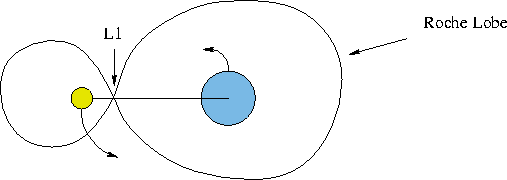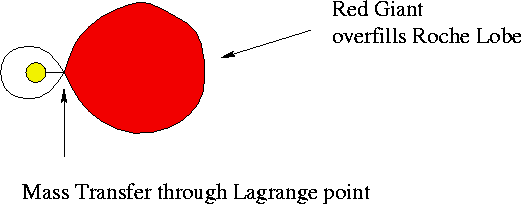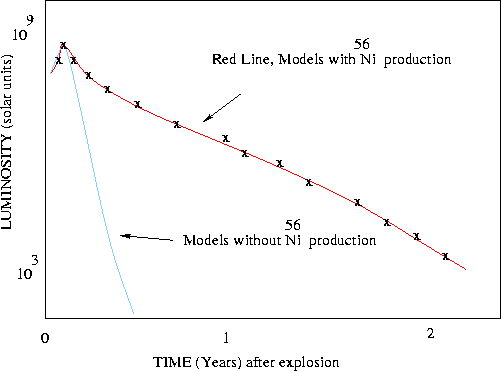Evolution of Low-Mass Binary Stars
- A Good Astronomical Puzzle - Algol
- Algol (also known as β Persei) is a double-lined, eclipsing,
spectroscopic binary with an orbital period of around three days.
Component A: B8 3.7MSun main-sequence star
Component B: G5 0.8MSun "subgiant" star
- What is wrong with this? The 0.8MSun
star should evolve MORE slowly than the 3.7MSun
star and should still be on the main-sequence.
- The solution has to do with the short-period orbit.
- The Algol Story:
- In the beginning, there were two stars, A at
1.2MSun and B at 3MSun. There is
a point between the two stars where the gravitational
pull of Star A is equal to that of Star B. This is
called a "Lagrange Point" and there is an
hourglass(ish) shaped "equipotential surface" called
the Roche lobes. (Note that this is in a strange
rotating reference frame).

- As Star B begins its trip up the Red Giant branch
it swells until its radius reaches the L1 point (or,
until its radius exceeds its Roche Lobe radius) and
Star B begins to spill mass through L1 to Star A.
This is called a Mass Transfer Binary.

- Under certain circumstances, Star B can transfer
enough mass to Star A so that Star A becomes the more massive
of the two. This looks like Algol.
- You can have even Weirder things happen in
mass-exchange binaries.
Think about continuing evolution for case where most of the Star B
mass gets exchanged.
- Now have a Helium WD (B) plus a massive
Main-sequence Star (A)
- When Star A begins its evolution up the RGB it
will reach its Roche Lobe radius and star to spill
material back onto B (now a He WD).
- As mass accumulates on the hot surface of the WD,
it traps radiation, heats up and when T reachs
107 K the hydrogen begins fusion to He and
there is a dramatic flare-up in the luminosity of the
system.
| Increase in L |
Name |
| 10X |
Dwarf Nova |
| 10,000X |
Classical Nova |
- Because the fusion is on the surface of the WD, there
is an ejection of material at ~2000 km/sec.
- Sometimes, the mass accretion stars up again leading to
Recurrent Novae.
- Every year there are 10 - 20 bright novae in the Galaxy.
Type I Supernovae
If you take pictures of a galaxy night after night (or better yet take
pictures of lots and lots of galaxies night after night) you will find
that now and then there is a new, very bright light source in the
galaxy. The new source can often be as bright as a small galaxy
(nearly a billion times as luminous as the Sun). These spectacular
explosions are Supernovae and one particular type, SNI, have
the following properties:
- SNI - No hydrogen seen in their spectra
- Found in All types of galaxies including ellipticals
- Seen everywhere within galaxies (Halo and Disk)
- Maximum brightness: 6 x 108 (!!)
- Supernove searches find ~25 per year in other galaxies
- What is going on? Remember the equilibrium of a RGB core or
a WD. e- degeneracy is balancing gravity.
- Remember the 1.4MSun Chandrasekar Limit for WD
masses.
- The idea is, mass accretion onto a WD in a binary adds
enough mass to the WD to push it over the Chandrasekar
Limit. Because of the funny way e- degeneracy
works, for the same reason the Helium Flash happens, now in
the 1.4MSun + a-little-bit WD the temperature
shoots up and within second a fusion chain triggers that fuses
elements all the way up to radioactive Nickel.
- The WD had a runaway thermonuclear catastrophe! This
star has exploded!
- What is RIGHT about this theory?
- Would expect to see these objects in "old"
populations (Elliptical galaxies and the halos of
Spiral galaxies)
- Models of what happens when you add a little mass
to a 1.4MSun WD give the right total
luminosity for the explosion
- The prediction of the models that lots of
56Ni will be produced in the explosion fit
the Light Curves perfectly



